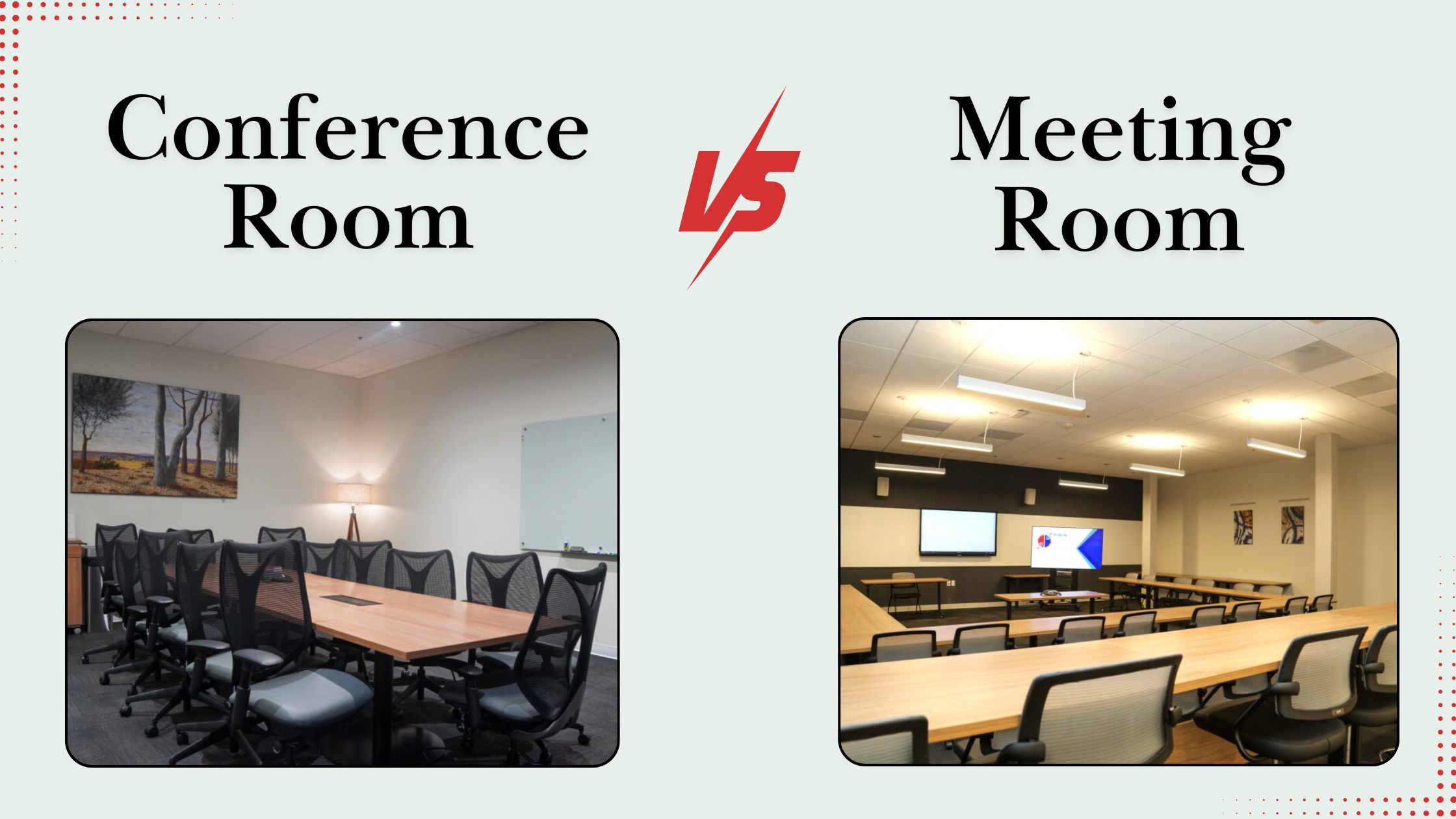Difference Between Conference Room vs. Meeting Room

Have you ever wondered whether the conference room and the meeting room are the same thing? Although these terms are often used interchangeably, the fact is that they represent spaces with very different functions in the contemporary workplace. In understanding the difference between conference room vs meeting room, they are both vital in communication, collaboration, & decision-making processes, but how they are designed, equipped, and utilized can significantly affect the outcome of any business interaction.
This difference is crucial for any organization, whether you are establishing a new office, renting a workspace, or restructuring an existing one. The appropriate environment will make your team and your clients productive, professional, and comfortable. It would be interesting to consider what makes these two critical spaces different and how their proper definition can make businesses run more efficiently.
What Is a Meeting Room and its Purpose?
A meeting room is normally a smaller & more intimate room that is used to make internal discussions, brainstorms, and teamwork. The rooms are needed in the day-to-day operations as the employees can meet and discuss ideas, develop projects, or address difficulties.
The main aim of a meeting room is to establish a friendly and interactive environment that will encourage communication and innovativeness among the team members. Meeting rooms, unlike conference rooms, are usually less formal and can be easily configured to suit the requirements of teams, since these rooms are flexible and can be changed easily.
Key Features of Meeting Rooms
1. Small and Efficient Layout
The meeting rooms are typically made to suit the small groups of individuals, two to ten persons. This will encourage close communication, quicker decision making, and involvement of all individuals.
2. Informal and Participatory Design
A meeting room should be designed to facilitate creativity and teamwork. It usually incorporates adjustable furniture, writing boards, & computer technologies to enable the discussion and sharing of ideas quickly.
3. Simple but Efficient Equipment
The tools available in most meeting rooms include basic yet effective equipment, such as whiteboards, small screen displays, and high-speed internet. They are enough to make fast catchups or internal reviews.
4. Flexible Usage
Meeting rooms can serve a range of purposes, whether it is an entire team briefing, a solo meeting, or a small training session. They are very versatile and cannot be ignored in the contemporary office environment.
What Is a Conference Room and its Use?
A conference room is a bigger & more formal area designed for essential discussions, consumer conferences, executive sessions, and departmental gatherings. It is the professional aspect of an organization and tends to be loaded with high-tech technology to facilitate mass communication.
Conference rooms can serve as a platform for making important decisions, negotiating, and conducting official communication. Such rooms should also demonstrate professionalism, attention to detail, and fascination with effective communication that the organization embodies.
The following are the main characteristics of the conference rooms:
1. Professional and Formal Environment
The design of the conference rooms is meant to impress. They commonly serve the purpose of client meetings, as well as presentations to investors and boardroom meetings. The furnishing, lighting, & atmosphere are well-maintained to communicate an impression of professionalism and credibility.
2. Innovative Meeting Area and Conference Room Facilities
The conference rooms have high-quality audiovisual systems, video conferencing tools, big screens, microphones, and sound systems. These meeting and conference room services are highly developed to provide participants (both in-house and online) with a seamless opportunity to communicate without technical issues.
3. Capacity and Space
The number of people that can be accommodated in a typical conference room is higher than that of a meeting room. The design usually incorporates the table at the center with the executive seating to make everyone comfortable to participate in the conversation.
4. Structured Purpose
A conference room is supposed to be a place where the decision-making process, formal presentations, & strategic discussions can take place. These rooms are useful in establishing relations with clients, investors, and the senior stakeholders.
Key Differences Between Meeting Rooms and Conference Rooms
Although both serve the purpose of communication & collaboration, meeting and conference rooms differ in various aspects. Understanding these differences assists businesses plan their workspace successfully and ensure each area serves its intended purpose.
| Aspect | Meeting Room | Conference Room |
| Purpose | Designed for small group discussions, brainstorming, or daily team meetings. | Used for formal presentations, strategic meetings, and client interactions. |
| Size | Compact and suitable for small groups (2–10 people). | Larger, accommodating multiple participants (10–30 or more). |
| Atmosphere | Casual and collaborative. | Formal and professional. |
| Technology | Basic tools such as screens, whiteboards, and the internet. | Advanced technology with AV systems, projectors, and video conferencing. |
| Participants | Primarily, internal team members. | Includes executives, clients, or external stakeholders. |
| Design | Simple, flexible, and easily reconfigurable. | Structured layout with executive seating and fixed setups. |
Both types of rooms complement each other, meeting rooms to boost creativity & collaboration, while conference rooms emphasize structure and formality. Together, they form the cornerstone of efficient and productive business communication.
Why the Right Room Matters
One can just imagine entering an office that features both a comfortable meeting room for team brainstorming and a state-of-the-art conference room for presenting clients. This mix is what makes your workspace fulfilling because it strikes a balance between creativity and professionalism.
Being aware of what is in a conference room and what is in a meeting room will enable businesses to create environments that will be productive and cooperative.
What Should be in a Conference Room:
- Relaxing and comfortable seats.
- Large conference tables, where the group can gather to discuss.
- Rich video conferencing tools for hybrid meetings.
- Touch board, digital connection, and projectors.
- There should be proper lighting and soundproofing to maintain a professional appearance.
What Should be in a Meeting Room:
- Minimalist structure on small teams.
- Brainstorming and whiteboards.
- Portable furniture is to be flexible.
- Swift Wi-Fi and mini screens.
- A peaceful atmosphere for concentration and solitude.
When these aspects are differentiated, businesses will be able to make each formal and informal meeting effective, fruitful, and valuable.
The Modern Shift: Hybrid Work and Smart Room Design
The work environment has undergone significant changes, particularly with the emergence of hybrid workplaces. With teams working in several geographical settings & time zones, the need for flexible and well-furnished meetings and conference rooms has increased.
Sophisticated offices currently incorporate the functionality of both types of rooms, thereby forming multi-purpose areas that can adapt to changing needs. An example is that a meeting room can be transformed into a small conference room by utilizing modular furniture and digital technology.
Among the major trends in the modern workspaces, one may identify:
- Technology Integration: Fast internet, electronic whiteboards, & video conferencing.
- Flexibility: Adaptable designs, which accommodate small and large teams.
- Sustainability: LED lighting and intelligent thermoregulation.
- Hybrid Connectivity: Tools that provide smooth teamwork between the on-site team and the remote teams.
This development shows that the boundaries between meeting & conference rooms are becoming increasingly unclear, but their fundamental functions remain distinct. Companies are finding ways to combine dynamism and formality to be more efficient and interactive.
Finding the Right Space to Conduct Your Business
It is essential to consider the type of space you truly need before planning your next meeting. Do you need to brainstorm in a small group or discuss clients in a professional setting? The decision you make should be based on the objective, the audience, & the size of the meeting.
If you’re exploring office space for rent in Dublin CA, look for workspaces that offer both small private and affordable private office space for rent in Dublin, CA equipped with advanced meeting and conference room facilities. These alternatives guarantee that your enterprise has accessibility to flexible, tech-ready workplaces that align with your operational goals.
To Sum It Up
If you are looking to rent a coworking space in Dublin for corporate meetings, events, conference rooms, or other spaces tailored to your needs, get in touch with us today. We provide luxurious office spaces and team rooms for lease, offering an excellent combination of innovation, comfort, & functionality. Whether you’re hosting a small brainstorming session or a large-scale conference, our workplaces are designed to inspire productivity, professionalism, and long-term success.



